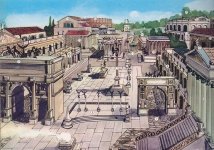Vallicanus
Regular Member
- Messages
- 1,195
- Reaction score
- 466
- Points
- 83
- Y-DNA haplogroup
- R1b Z36
The earliest evidence for wheeled vehicles is in Europe, the earliest of all in the area of the Cucuteni-Trypillia culture:

- Klimsha (2017), Wheeled vehicles
“The present evidence for early wheeled transport does not support the traditional belief in the oriental invention of wheel and wagon. Full-size wheels and axles from central and eastern Europe clearly pre-date the earliest wheels from the Near East, and the indirect evidence (models, depictions) does not allow for a temporal gradient indicating diffusion ex oriente. Two alternative hypotheses remain. Innovation could have happened roughly simultaneously, but independently, in several regions (the polycentric model). … Alternatively, there was only one innovation centre. Following Maran (2004b), the late Tripolye culture (around 3700-3500 BC) in the steppe area north-west of the Pontic Sea is the most likely candidate for inventing wheeled transport”
- Schier 2015, Oxford Handbook of Neolithic Europe, p.113
Fake news.




